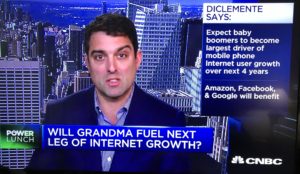CNBC Drops a Marketing Bomb
A recent CNBC story caught my attention.
Millennials as a demographic have been the focus of technology and those companies using tech to attract them.
 However, this CNBC story featured analyst, Anthony DiClemente, who made a compelling statement. The growth of Internet phone usage will be strongest among baby boomers. The story focused on healthcare marketing, but the core message extends to many segments.
However, this CNBC story featured analyst, Anthony DiClemente, who made a compelling statement. The growth of Internet phone usage will be strongest among baby boomers. The story focused on healthcare marketing, but the core message extends to many segments.
In my opinion, this has some pretty important marketing implications.
I think you’d agree that there are two items we rarely leave our homes without. The first is our car keys. The second is our phones.
Mobile phone technology offers us a unique opportunity to reach into the lives of consumers in our target markets. Print media is virtually dying on the vine. Television media has been losing steam for quite some time. We are very rapidly approaching a completely on-demand lifestyle.
Think about it. Many of us have had the ability to DVR or TiVo television shows for years. The primary benefit is convenience. But the real value for many is that we can skip through commercials, thus avoid them altogether.
Cable companies are beginning to unbundle your services because they realize it’s what clients are demanding. We want what we want, when we want it.
Even Keurig was able to take advantage a niche for on-demand consumption, although this form of consumption is obviously different. Some haters would argue their Keurig is more valuable than the article you’re reading. I’d counter they’re complementary. (Pause to take another sip between paragraphs.)
Many of the companies I worked with early on were extremely hesitant to jump online as part of their marketing strategy. They viewed the Internet as something the younger kids were using, namely those without enough money to hire them or buy their services. That mindset is rapidly changing.
The CNBC story hints at the need for them to do so, if they haven’t already. But it’s not just about written content.
Companies are now going to need to strongly consider the mode and the medium they are using to convey that information.
With the rapid adoption of Internet phone usage, especially among baby boomers, one thing that won’t work is long-form, text-based content. Think about it, no one wants to scroll and scroll and scroll through a complicated article using a 2- or 3-inch screen. It’s just a poor user experience.
 Heck, half of the boomers may not be able to read the type anyway. That’s not a slam, that’s just a fact of aging. I’m a Gen X’er but even I’m wearing my glasses more and more frequently.
Heck, half of the boomers may not be able to read the type anyway. That’s not a slam, that’s just a fact of aging. I’m a Gen X’er but even I’m wearing my glasses more and more frequently.
I’ve asked this question before. What format works extremely well, and is perfectly adapted for a small mobile screen? Once again, the answer is video-based content.
For many companies, their ideal consumer is a member of the baby boom generation. They have money. They have disposable money. Boomers are at a point their lives when their needs have definitely changed. Those changes can open up terrific opportunities for those who are savvy enough to appeal to their new, ever-changing needs.
But how do you convey the message? Are you packing enough emotion and excitement to inspire them to act on that message? I’m pretty sure the right approach is not a 1,500-word tome about your value statement and product details.
A video strategy to implement video-based content is the answer. It can deliver a message that’s much more personal. It allows a consumer to “connect” with a brand (one of the holy grails for any marketer). Most importantly video-based information has a much higher retention rate that text-based. After all, if you’re going to go through the effort of crafting a great message, distributing it and capitalizing on it, wouldn’t it be nice if your target audience actually understood and was able to recall that message? Absolutely.
Begin Thinking about a Video Strategy
As we move into 2018, it’s not too late to begin considering how you can develop a plan to migrate your content to a video-based format. When executed properly, there’s a synergy between text and video content. Videos on a page, or in a blog post, can quickly catch the viewer’s attention. This often leads to their willingness to read the rest of the page. That’s an important reason to consider a video strategy.
Consider ways to implement a video strategy to deliver a much more compelling message. The market is already crowded. Most people reading this article will admit they aren’t the only provider of their types of services. Video-based content can help you break out of the white noise of your competition.
Think of it this way, if your market includes baby-boomers, they’re primed for video content. The advantage is that younger consumers (Gen X, Gen Y and Millennials) already expect it. Don’t miss out on an opportunity to cater to a large segment of your market. Video is the medium you and your market have been waiting for. Luckily for you, it’s already here. It’s time to begin working on a 2018 video strategy.








Leave a Reply
Want to join the discussion?Feel free to contribute!